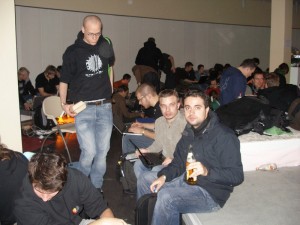The following post is going to be a one in a series of 2-3 posts regarding netroute2 (the link is in Greek) and some of my hacks/modifications on it. All hacks refer to netroute2 firmware 577 that I have previously posted on my blog. For those who haven’t noticed yet, firmware 577 is unlocked, you can now connect to any ISP you like.
Netroute2 has a strange bug and sometimes (not always) cannot reconnect to the ISP when the connection for some strange reason goes down. To cope with that, the netroute2 developers at Intracom have created a script named high_avail that runs every 5 minutes from crontab. For some even stranger reason this script did not work for me as it should, so I patched it to make it _always_ work.
The problem I faced at the very beggining was that the “high_avail” script resided in the read-only section of netroute2’s flash (/usr/bin/high_avail). My solution to that problem was to create a directory named /etc/bin/ and store there all my new scripts and changes since the /etc dir is writable.
My changes to the high_avail script are these:
--- usr/bin/high_avail 2007-07-03 20:59:21.000000000 +0300
+++ etc/bin/high_avail 2007-07-04 03:31:54.000000000 +0300
@@ -15,25 +15,32 @@
if [ -s /var/run/dial ]; then
act_conn=`$CAT /var/run/dial`
fi
-adsl_iface=$ADSL_BASE
+if [ -z "$act_conn" ]; then
+ act_conn="/etc/wan/current/CHANGEME"
+fi
+
+adsl_iface=$ADSL_BASE
+echo "$act_conn"
reload_module() {
/bin/hangup
+ killall -9 pppd
+ ifconfig eth2 down
/sbin/rmmod $loaded_mod
if [ $? -eq 0 ]; then
$ECHO "done"
else
$ECHO "failed"
$ECHO "ERROR: high_avail: Failed to unload $loaded_mod"
- exit 13
+# exit 13
fi
- [ -n "$act_conn" ] && /usr/bin/dial $act_conn
+ [ -n "$act_conn" ] && /etc/bin/dial $act_conn
}
HIGH_AVAIL_IP=`$GREP HIGH_AVAIL_IP /etc/net.conf | $CUT -d'=' -f2`
-
#Check Current Modem status
if [ -z "$loaded_mod" ]; then
$ECHO "high_avail: No Module found loaded."
+ reload_module
exit 1
elif [ "`/usr/bin/modem_wrap halt`" = "yes" ]; then
$ECHO "high_avail: Module $loaded_mod found in HALTED state"
@@ -41,6 +48,7 @@
exit 11
elif [ -z "$act_conn" ]; then
$ECHO "high_avail: No WAN Connection dialed ..."
+ reload_module
exit 2
elif [ -z "$HIGH_AVAIL_IP" ]; then
$ECHO "high_avail: No Ping Target IP Found ..."
and the whole new script resides here: /etc/bin/high_avail. (You need to gunzip it).
What you need to change for your connection is the part that says CHANGEME. You can replace that with what you can find inside the /etc/wan/current/ directory.
I noticed that when the module for the modem was loaded then the modem was unable to reconnect to the ISP, but upon unloading and reloading of the module, and then trying to connect again, all came back to normal. So what I changed in the high_avail script was making sure the module gets unloaded properly and reloaded when there’s no connection active.
One might notice that inside high_avail I’ve also changed a path from /usr/bin/dial to /etc/bin/dial.
This script is used to call another script that actually makes the call to the isp.
--- usr/bin/dial 2007-07-03 21:00:13.000000000 +0300
+++ etc/bin/dial 2007-07-04 03:39:45.000000000 +0300
@@ -1,25 +1,16 @@
#!/bin/sh
ECHO=/bin/echo
-
conn="$1"
#ATM encapsulation mode for modem
encmode=0
-
$ECHO "Dialing $conn ...."
-
if [ $# -lt 1 -o ! -e $conn ]; then
-
$ECHO "Usage: dial <connection> [ppp_option]"
$ECHO "connection: connection name"
$ECHO "[ppp_option]: optional argument passed to PPPD"
-
exit 1
-
else
-
#Bring down previous processes
/bin/hangup
-
- /usr/bin/dial_conn $conn primary_conn $2
-
+ /etc/bin/dial_conn $conn primary_conn $2
fi
These are my changes to /usr/bin/dial script that is now placed under /etc/bin/dial
The whole scripts resides here: /etc/bin/dial. (You need to gunzip it).
As said before, this script in turn calls another one, dial_conn which is used to actually make the call. My changes to /usr/bin/dial_conn which now becomes /etc/bin/dial_conn:
--- usr/bin/dial_conn 2007-07-03 21:00:13.000000000 +0300
+++ etc/bin/dial_conn 2007-07-04 03:43:11.000000000 +0300
@@ -154,14 +154,13 @@
exit 1
fi
done
-
fi
-
if [ "$2" = "primary_conn" ]; then
#Start the high-availability service
- $ECHO "*/5 * * * * root $PIDOF high_avail > /dev/null 2>&1 || /usr/bin/high_avail > /var/run/high_avail 2>&1" > /etc/cron.d/cron_high_avail
+ $ECHO "*/5 * * * * root $PIDOF high_avail > /dev/null 2>&1 || /etc/bin/high_avail > /var/run/high_avail 2>&1" > /etc/cron.d/cron_high_avail
$CHMOD 755 /etc/cron.d/cron_high_avail
fi
-
+ sleep 5
+ #/etc/bin/wshaper ppp0 192 1024
exit 0
fi
the whole file resides here: /etc/bin/dial_conn. (You need to gunzip it).
What I’ve changed here is the line that gets stored on crontab and calls the high_avail script every 5 minutes to check whether our connection is active or not. The rest of the changes will be the subject of the next post about netroute2 on this blog.
What is left now is to make netroute2 calls these new scripts from /etc/bin/ on boot instead of the ones from /usr/bin.
a) Copy /bin/dial_current to /etc/bin/dial_current, edit it with vi and go to line 5 and change the line that says /usr/bin/dial with /etc/bin/dial.
b) Edit /etc/init.d/rc-run, go to line 243 and change all occurences of /bin/dial_current with /etc/bin/dial_current. There must be 2.
c) Edit /etc/rc.d/rc.dialcurrent with vi, go to line 8 and change /usr/bin/dial to /etc/bin/dial.
So, if you have done it right, you should now have 4 scripts inside your netroute2’s /etc/bin:
a) /etc/bin/high_avail
b) /etc/bin/dial
c) /etc/bin/dial_conn
d) /etc/bin/dial_current
and you should have also changed 2 scripts, /etc/init.d/rc-run and /etc/rc.d/rc.dialcurrent
That’s all. Now save your changes with /etc/init.d/checkpoint and upon reboot your modem will have a nice new high_avail script that will (hopefully) always work.
 Filed by kargig at 11:25 under Linux,Networking,Privacy
Filed by kargig at 11:25 under Linux,Networking,Privacy 5 Comments | 30,387 views
5 Comments | 30,387 views








